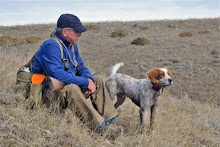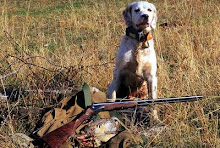I suggested my first post might be a review of Dave Walker's Bird-dog
 Training Manual. My copy showed up a few days ago and here's a few preliminary observations. I should say that while I knew Dave's name and reputation, I found reference to the book on Jon Lee's great Pointing Dogs blog. The first thing that caught my attention was the assertion that Dave, an American Brittany Club Hall of Famer, eschewed gizmos like whoa barrels, choke collars, and half-hitches round the belly.
Training Manual. My copy showed up a few days ago and here's a few preliminary observations. I should say that while I knew Dave's name and reputation, I found reference to the book on Jon Lee's great Pointing Dogs blog. The first thing that caught my attention was the assertion that Dave, an American Brittany Club Hall of Famer, eschewed gizmos like whoa barrels, choke collars, and half-hitches round the belly.When I come across new bird-dog owners, I generally recommend that they read Ben Williams's Bird Dog: The Instinctive Training Method. Ben's book is as much as book about the joy of hunting with dogs as it is about actually training them -- and avoids getting caught up in all the bells and whistles (literally), collars, training tables, and check-cords. Importantly, it lets prospective bird-dog owners know what's possible with just time, clear communication, and birds. Arguably the challenge for most regular folks is that Ben is blessed with wide-open spaces and wild birds to train on.
Dave relies on three pieces of equipment: a check-cord, a training collar, and an e-collar. He also relies on a communication sequence that uses verbal, non-verbal (but acoustic), and the least amount of stimulation necessary to signal to the dog that it is now being asked to do something different. And all of this starts with what he calls "the art of walking a dog." The other critical piece of advice he repeats over and over is to keep your mouth shut. Especially when training, keep your talking to your dog to a minimum -- to give the words that you do speak more significance.
This last piece of advice is one that rings especially true for me. I feel pretty comfortable saying that most of my older dog's sins or failings are inherited from his dad not knowing exactly what he wanted, not knowing how to ask for it, and talking too much in between. One of the things I appreciate about Dave's book is that in what is largely a filler chapter in most dog-training books, 'Choosing Your Dog,' he does include four clear skill-set phases in a dog's development that take the dog from being to steady-to-wing through retrieve-on-command. As with much of the book, Dave sets out clear learning goals for each phase. If I'd had a clearer idea of what I might have been able to do with a bird-dog, maybe I would have talked less at my older dog.
I won't go into all the details of the book, except to say that a) it relies on a clear sequence of skills, and b) that I learned a bunch of things that I don't think I'd read elsewhere. For example, I found Dave's chapters on 'Using Training Birds' and 'Training in the Field' to be well worth the book as a whole. The 'Training Birds' chapter is short, but has enough suggestions on how to actually and humanely limit training birds' flight (using tethers or plucking primary covert feathers) to be well worthwhile for relative newbies like me. The field training chapter walks you through the sequence of skills that make a good dog a finished dog that starts with the foundation skill of stop-and-stand-still -- and I wish I'd read the book when it first came out in 2005. That doesn't mean that other folks like me are screwed when it comes to applying a lot of Dave's method into the skills our dogs already possess, but it does mean that things might have been smoother at this point. And there's still time for me to get that rock solid honor in place.
Dave has a really straighforward writing style, but there were some things I wish I could have seen in practice. Take advantage of the video clips on Dave's site -- the one on his training collar makes it a lot clearer to me how it does (and importantly, doesn't) work. Nevertheless, I would love to see how Dave 'circles' a dog when it starts to break point - the idea sounds great, but I can't quite picture it in practice. Perhaps needless to say, Dave has a bunch of DVDs available. Again, check out the clips on his website -- he looks like a hoot. Sounds like he had a nice dinner with Jon Lee, too.
If you're thinking about starting a new pup, and you want to try most of the training yourself, I think Dave's book is a good investment. You're still going to need time, patience, and above all to help your dog by keeping your mouth shut.









1 comment:
Andrew...thanks for reviewing Dave's book. Yesterday I was thinking about ordering it from the American Field. Now I will for sure! Good job!
Post a Comment